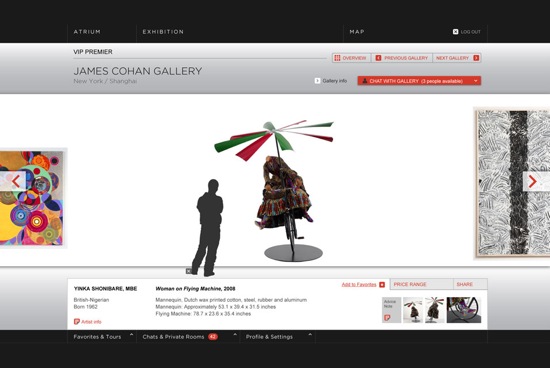

In 2010 the fashion and luxury industry starred in the digital space, could the world of fine art be next? How could online interactions transform the way we discover emerging artists and buy art? There already have been efforts to innovate and mix technology and art that get a lot of attention, most recently VIP Art Fair, a virtual fair featuring some of the world’s leading contemporary art galleries launched for the week January 22-30, 2011.
VIP, which stands for “viewing in private,” Art Fair shows works by more than 2,000 artists, emerging and established like Francis Bacon and Damien Hirst. Entrance to the site is free, but a VIP pass (costing now $20) provides access to more detailed information, tours of private collections, a guided tour of the fair by a museum curator, access to the price ranges for each work and the potential to contact the dealers through instant messaging, phone or Skype. The deals remain an offline story, as the fair does not provide the option to complete a purchase online. The visitor can click through galleries, zoom in on high quality images, see the installations from different viewpoints, along with information in text or video and create tours of their favourite works to be shared by email and social media.
We contacted VIP Art Fair Co-Founder Jane Cohan (also director of Press Relations NY for the James Cohan Gallery) to talk more about the vision behind the virtual fair as well as how technology could shape up the future of fine arts.
What was the greatest challenge you faced in organizing the fair?
We wanted to create a really rich user experience with features such as zoom, and video and lots of supporting materials about the artists and the ability to create and follow tours and yet, we wanted it to be straightforward and easy to use. This is always at the crux of any design project; how to make something contain so much and appear clear and simple.
What actions did you take to encourage the collectors to invest in such big purchases though the web? Do you plan to implement the option to complete a purchase online too?
Buying art tends to have a very long sales cycle. For the collector and the dealer, a sale usually begins with getting to know one another. For our collectors who know the artists’ work well and have established relationships with the galleries, they might feel comfortable to buy a work they see on the website, for others, they might be introduced to a work online and then make plans to travel to the galleries to see the artwork and shake a hand.
How did you use social media for VIP Art Fair?
We used social media to keep our visitors well informed about the dynamic program happening at the fair. In the VIP Lounge, we have two film series, one created by the renowned documentary filmmakers ART21 that is a series of 18 films about artists and the other we are calling Collections in Private that is a series of tours through collector’s homes and collections. Also The Art Newspaper, produced a series of films about the fair that can be found on the Fair’s news page. Also accessible from the VIP Lounge, visitors can take tours through the fair by well-known collectors and curators. Today tennis star John McEnroe created a tour of over 30 works of the fair with his comments on why he chose those pieces.
How did you balance the openness of the web with the exclusivity collectors demand traditionally? Have you noticed a change in the identity and buying habits of the art collector today?
I think the habits might be the same but the big difference is the number of people interested in collecting contemporary art. There are collectors the world over who want easier access to the galleries and opening up this marketplace to the Internet allows them that access. Not everyone can travel to the fairs and yet they don’t want to miss out. Collectors don’t have to disrupt their schedules as much anymore now that there is VIP Art Fair.
Are there any plans to mix online fairs with “in real life” exhibitions?
We have heard of friends getting together to have parties to “go” to the VIp Art Fair together. This is a fun idea. And one of our galleries, Unlimited in NYC is exhibiting images from their booth at VIP Art Fair as the images in their real booth at the LA Art Fair later this week. The gallery director will be directing all of his “IRL” (In Real Life) clients who visit his booth in LA to the website. His artist, Brendan Fowler is making a performance in the live booth that looks like a web booth once a day. It is so fun to play with what is real and what is virtual.
How do you see mobile, augmented reality and social media transforming the art world?
The artworld has a way of turning everything from the “real” world on its ear. That’s what makes it so much fun and so thoughtful. I think artists and dealers love to mix up the real and the social and the profound and the mundane, so I actually think it is the artworld who will bring that change to social media and augmented reality.
**
How do you envision the future of fine arts? Is the fine arts world ready to go social?
Get the TNW newsletter
Get the most important tech news in your inbox each week.




